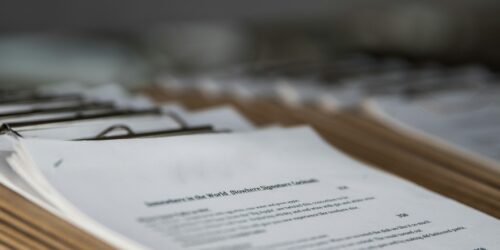
Preventing Cheating on Paper-Based Exams
What does the research say about the prevalence and causes of cheating across cultures? How can I set the tone for academic integrity in my classes? What are some ways I can create an exam environment which discourages cheating?
Relevant Policies
Conestoga’s Academic Integrity Policy includes the following offences related to examinations:
- Copying from another student in any evaluation situation.
- Possessing unauthorized material or aids in a test or examination situation.
- Allowing another person to take a test or examination in one’s place.
- Improperly obtaining through theft, bribery, collusion or other means, any test or examination paper prior to the date and time for writing such test or examination.
- Misrepresenting the reasons for deferring an exam or assignment.
- Submitting false medical, academic or other documentation.
- Aiding or abetting anyone in an act of academic dishonesty.
Scholarship of Teaching and Learning
A review of studies by Stonecypher & Willson (2014) found that a range of 21 percent to 90 percent of college students from all majors reported cheating. In an earlier study comparing cheating internationally, Grimes (2004) found that academic cheating is a common activity in all of the countries surveyed with an average of 49% of students stating that “cheating is socially acceptable,” 85% “consider cheating to be ethically/morally wrong,” and 92% having a “fear of punishment if caught cheating.”
Using gaming theory, Ling & Li (2015) determined that the possibility of cheating encourages students to cheat. They found three main contributors to students seeing cheating as possible:
- The classroom set up allows students to use information, communication, and the Internet to cheat.
- Monitoring is not effective enough.
- The exam paper and/or examination questions make cheating possible.
International Context
In a British study, data from 129 universities revealed that non-European Union students made up a disproportionate number of those caught cheating. This does not mean they necessarily cheat more. Of the 70 universities that provided data, non-European Union students were involved in 35 per cent of all reported cheating cases but made up only 12 per cent of the student body. International students may be easier to detect as they have more at stake and are less familiar with our systems. Advance test familiarization and sharing testing protocols will be especially helpful for these students.
Suggestions and Innovations
During the Semester
The following strategies aim at creating a classroom culture that emphasizes academic integrity, and helps students perceive the value in studying and preparing for their exams.
Outcomes Based Evaluation
When discussing upcoming evaluations, keep the conversation focused on the opportunity that the students have to show you evidence that they have met the expectations related to the course outcomes. Remind them of the alignment between the course outcomes, the learning opportunities you have provided, and the evaluation. Tell them that they don’t “lose marks” but earn marks for the evidence they provide in response to the test prompts.
Test Familiarization
Familiarize the students in advance. Let them know what types of questions will be provided: multiple choice, short answer, long answer, case studies, calculations, etc. Tell them how long the test will be in terms of pages and time. Tell them the type of visuals and graphs they can expect to see or create. Let them know if they can have access to study notes, calculators, software, etc. In class time or online, provide practice questions that are at the same standard of challenge as those on the test.
Cheat-Proof Your Assessment Questions
Make studying more appealing than cheating. Don’t wait till the day of the test to tell student how you try to cheat-proof your tests. Tell them at the beginning of the semester, and post your practices on eConestoga for them to refer back to.
Continually improve your assessment strategies so students realize that cheating is futile. If students know that they need to apply information and concepts to novel cases then the usefulness of planning cheating in advance is diminished. Writing test questions that require higher order thinking skills can have a positive effect into the way students approach learning the material.
Refresh your testing materials regularly. Students can quickly snap photos of test pages during take up and share them on Facebook or sell them in the hallways. It would be better for you to share copies of previous tests and exams for practice and ensure that you use new stimuli each time that requires novel application of the course’s learning.
During the Test
There are two main types of cheating with regards to unauthorized materials:
- planned cheating in which the student anticipates (or pays for) the test questions and answers. In these situations, the student will often attempt to bring the required answers into the test setting via paper, a Smart watch or a Smart phone.,
- on-the-spot cheating in which a student tries to access answers from another student orally or by looking at another’s test paper.
The following strategies try to help prevent either or both of these.
Prepare your Exams Accordingly
Have 2-3 versions of each test. Don’t spend your time making different questions, simply alter the order of either the questions or the answers so students cannot find an answer by glancing at a neighbor’s test. alternatively, have 3 unique data sets or three unique cases so that answers differ across three versions of the test.
Print your exam on non-white paper, and have another colour of paper available for rough work. Students who brought a smaller, white-coloured sheet to slip under their exam will be foiled. Make sure you use only pale colours that have a good contrast so students can read easily.
Secure the Testing Environment
Require that students bring their Conestoga ONECard as identification. Students may attempt to write each other’s test in large cohorts.
Do not let students choose their own seats. Consider numbering the seats 1-X and as students enter, assign them a random place. Or you can number the test papers and place them around the room and as students come in send them to the next number. You can also create a seating plan in advance and project it on the screen so students sit where assigned. Once everyone is seated, create a seating plan if you didn’t use one. Let the class know you will be doing so as evidence in the event that students submit similar answers.
Do not allow any watches, cell phones, Bluetooth devices, tablets, musical devices, programmable calculators, coats, bags or pencil cases to be within arm’s reach. All of these items could contain digital or print copies of course materials. Such items need to be left in lockers, placed in baggies, set along the front wall or placed away from the student’s reach under the table. Be aware that faculty in Ontario have caught students with extra cell phones on their persons so circulating around the room remains important. See a discussion of new cheating capabilities at ‘Cheating watches’ warning for exams.
Instructions Prior to Beginning Exam
Tell students that they need to take a sticker, write their name on it, and affix it to any water bottle or coffee cup they have with them during the exam. Tell them these items must be left behind on the table when they exit and will be inspected. Do not allow any food items or gum in the exam as wrapper notes are a popular cheating tool.
Tell students that you may randomly ask rows to stand and raise their arms during the exam time to check that no small slips of paper have been pulled out of pockets. Tell them this will also give them a stretch break.
While Students are Writing
Circulate to the four corners of the room during the exam. Do not sit at the front or move about predictably. If students can’t anticipate your next move, they will hesitate to access unauthorized materials. Place a chair at the back so you can be comfortable sitting there on occasion. Avoid wearing squeaky shoes. Do not stay at the computer. If you use the computer to check for messages from Accessibility Services, be sure not to make clickety noises on the keyboard.
Consider having a full class washroom break. For example, you can divide your test into two parts and collect Part A after 50 minutes, provide everyone with a 15 minute break and then handout Part B on their return. This way you can allow a timed washroom break. Students can chat and refresh their minds half way through.
If at all possible, buddy with another faculty member so both of you are in the room together for each other’s exams. This way you can escort to the washroom if needed. There is no way to check what happens in a cubicle but the idea of being escorted if known in advance, may cause second thoughts about planting a cheat sheet in a particular cubicle.
Once Exam Grades are returned
If you are worried that students will modify returned tests or answer sheets and request a re-write, use a fine-tipped permanent marker during marking. Avoid using a pencil to grade. This will make your grading indelible and hopefully not modifiable. If you are additionally concerned, take a photo of all exam pages before returning to a student on request. This way, you have a concrete record of the test in the state in which it was returned.
References
(2016). Student cheating crisis; Foreign influx fuels ‘epidemic’ as thousands buy exam success; Influx from overseas fuels plagiarism ‘epidemic’ at universities. The Times (London, England).
Grimes, P. W. (2004). Dishonesty in Academics and Business: A Cross-Cultural Evaluation of Student Attitudes. Journal Of Business Ethics, 49(3), 273.
Stonecypher, K., & Willson, P. (2014). Academic Policies and Practices to Deter Cheating in Nursing Education. Nursing Education Perspectives, 35(3), 167-179 13p.
Wang, J., Tong, Y., Ling, M., Zhang, A., Hao, L., & Li, X. (2015). Analysis on Test Cheating and its Solutions Based on Extenics and Information Technology. Procedia Computer Science, 55(3rd International Conference on Information Technology and Quantitative Management, ITQM 2015), 1009-1014.






